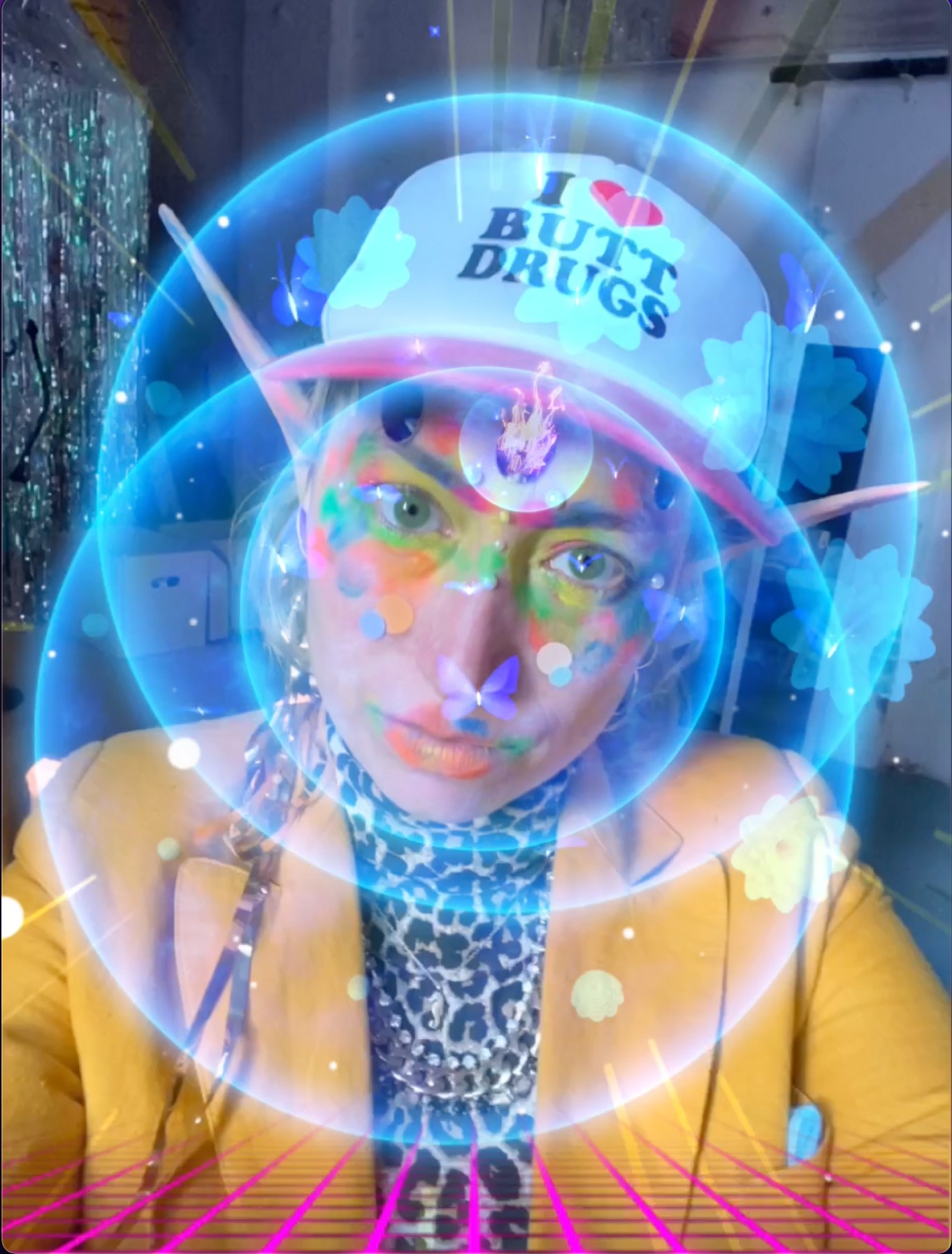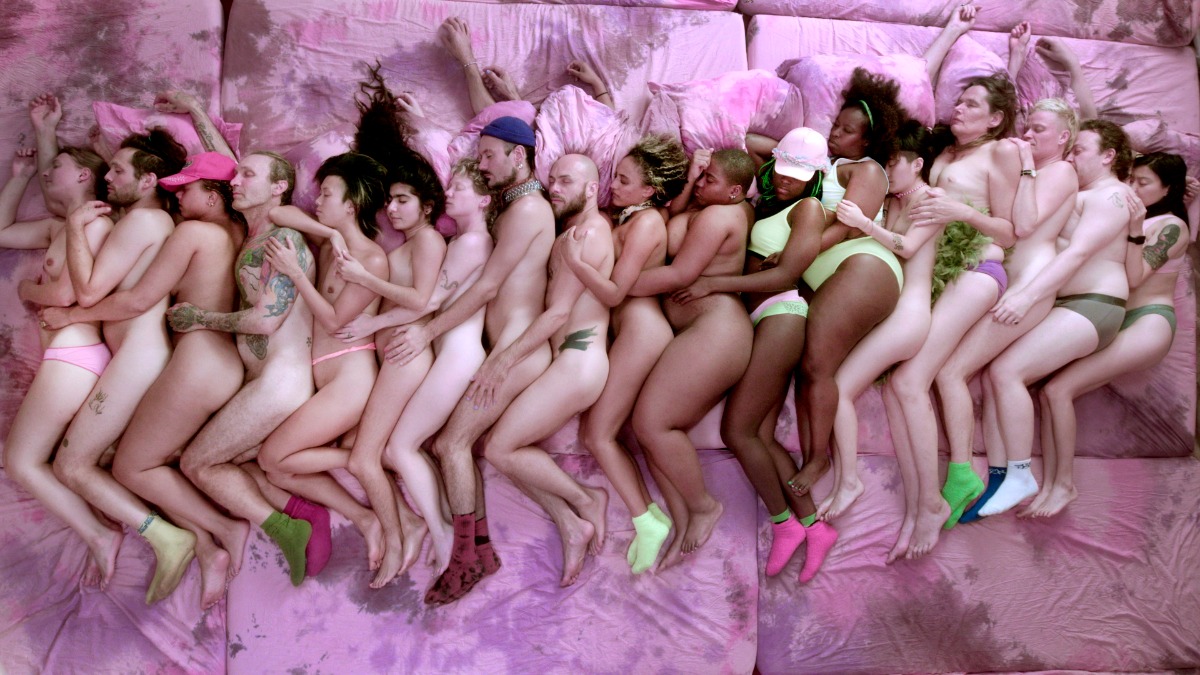
Celebrating the Body
An interview with Dutch artist melanie bonajo
‘When the body says Yes+’, a solo exhibition by Dutch artist melanie bonajo (they/them/theirs), opened on the fifth floor of the Kumu Art Museum in November. bonajo is searching for an answer to the question of whether there still is a place for intimacy in our increasingly commercialised and technological world. The central theme of the exhibition is touch, both literally and as our relationships to each other and the world around us. For bonajo, touch can be a powerful remedy for the modern epidemic of loneliness. Brigita Reinert, an art critic and the Head of the Contemporary Art Collection at the Art Museum of Estonia, talked with the artist about the exhibition, their creative work, and the current state of affairs in contemporary society.
melanie bonajo (on the left) at the opening of the exhibition. Photo: Joosep Kivimäe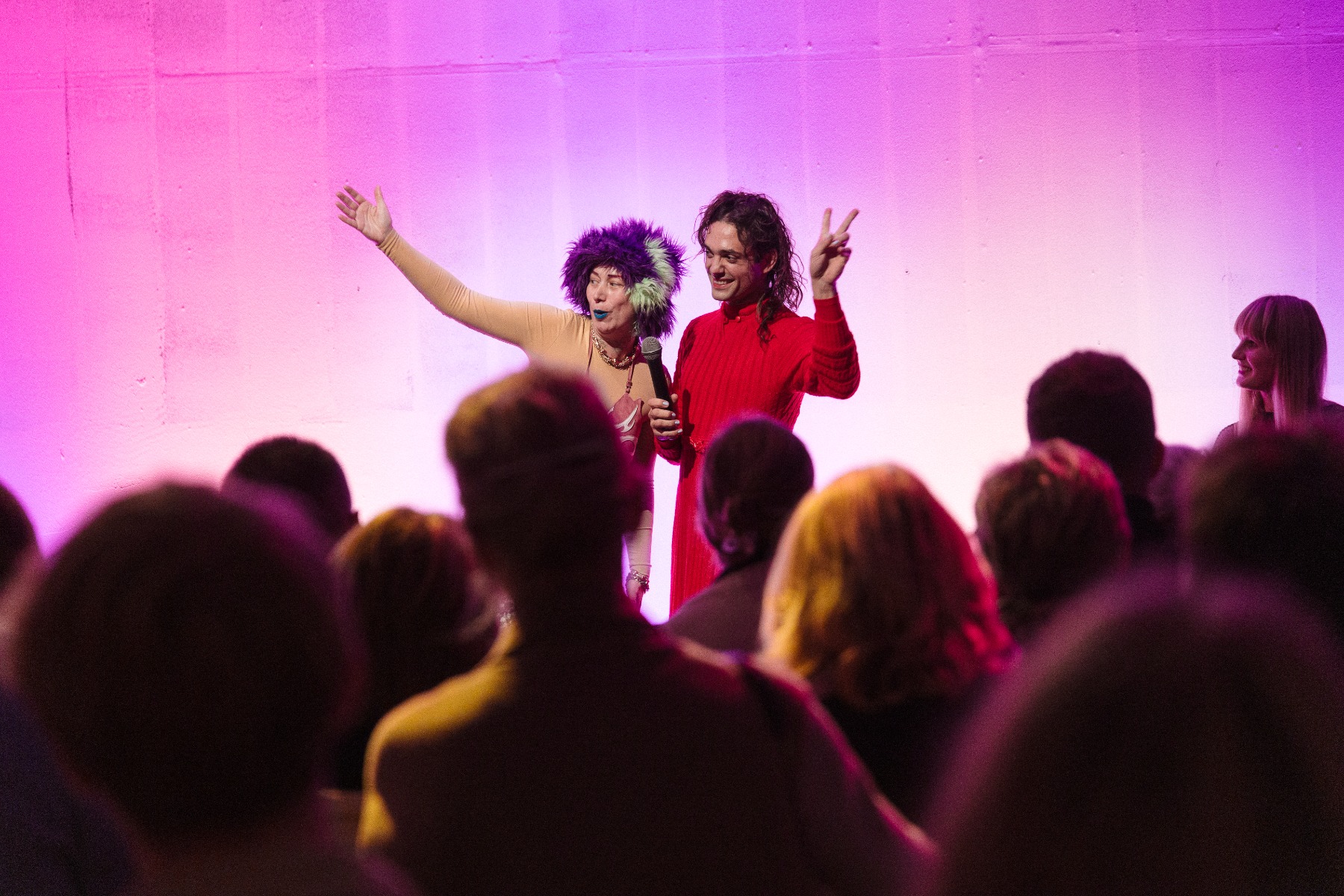
I understand that one of the directions of your work is to explore how technological development and the progress of contemporary society has affected us as humans. For example, how it has increased feelings of alienation and removed a sense of belonging as individuals. How do you see things? How has technology affected us and how do you approach this topic in your work?
We have this idea of connection in which we are always ‘on’ – the phone has basically become a part of our body, and through it we are always wired to other people. But what is lacking in this space is a sense of physical connection. Our nervous systems are wired for us to be together, to be part of a community. We learn when being with other people.
The digital space is connected, but it is not embodied or physical. Learning to be safe, connected, and having a sense of belonging with other people in a physical space has become less available. Spaces where one can feel closeness and as if one is being held are things that had been very much missing in my life. So I went on this journey to find spaces where I could be in connection with people – a connection that is not only a sexual or romantic relationship but one where you experience a proximity that feels much more like our childhood experiences with friends. In childhood, we did not have these boundaries – touch was not yet sexualised. I was really craving this place of innocence, and I realised it was not there. I am a sensory person; I like to touch people and I like to be touched and held. That’s why I wanted to take ‘touch’ out of the ‘sexual space’ and make it available as a broader language that we can all learn to speak. There are many other ways of enjoying touch, like a massage or holding each other. I started on this journey so as to create these kinds of spaces where I could experience that. And then I came to realise that a lot of people have these same cravings.
Exhibition view. ‘When the body says Yes+’ at the Kumu Art Museum. Photo: Stanislav Stepaško
When you look at it on the level of hormones, this digital space of connection through phones (and the digital realm in general) is based on a hormone called dopamine. You get a certain high when engaging in the digital space. Whereas the hormone in our bodies linked to the senses of bonding, trust, and safety with others in a physical space is called oxytocin. It has a different quality to it. I feel that once touch is introduced into a relationship, there is more safety and feelings of belonging, respect, relaxation and of being seen. There is more comfort about expressing discomfort, and more room for the restorative. When talking about the disembodied space / digital space, it seems more unsafe, and power dynamics are often in place: somebody is kept small while the other one is big – this is mostly related in terms of gender or sexual orientation. Once you create a space that has safety, all these dynamics start to change.
All of these thoughts were the basis for the main work at the exhibition, ‘When the body says Yes’. This work captures the moment when people feel safe and good in their body after a therapy workshop. It was a social experiment in which blindfolded and oil-covered people opened up to strangers and allowed themselves be filmed.
Exhibition view. ‘When the body says Yes+’ at the Kumu Art Museum. Photo: Stanislav Stepaško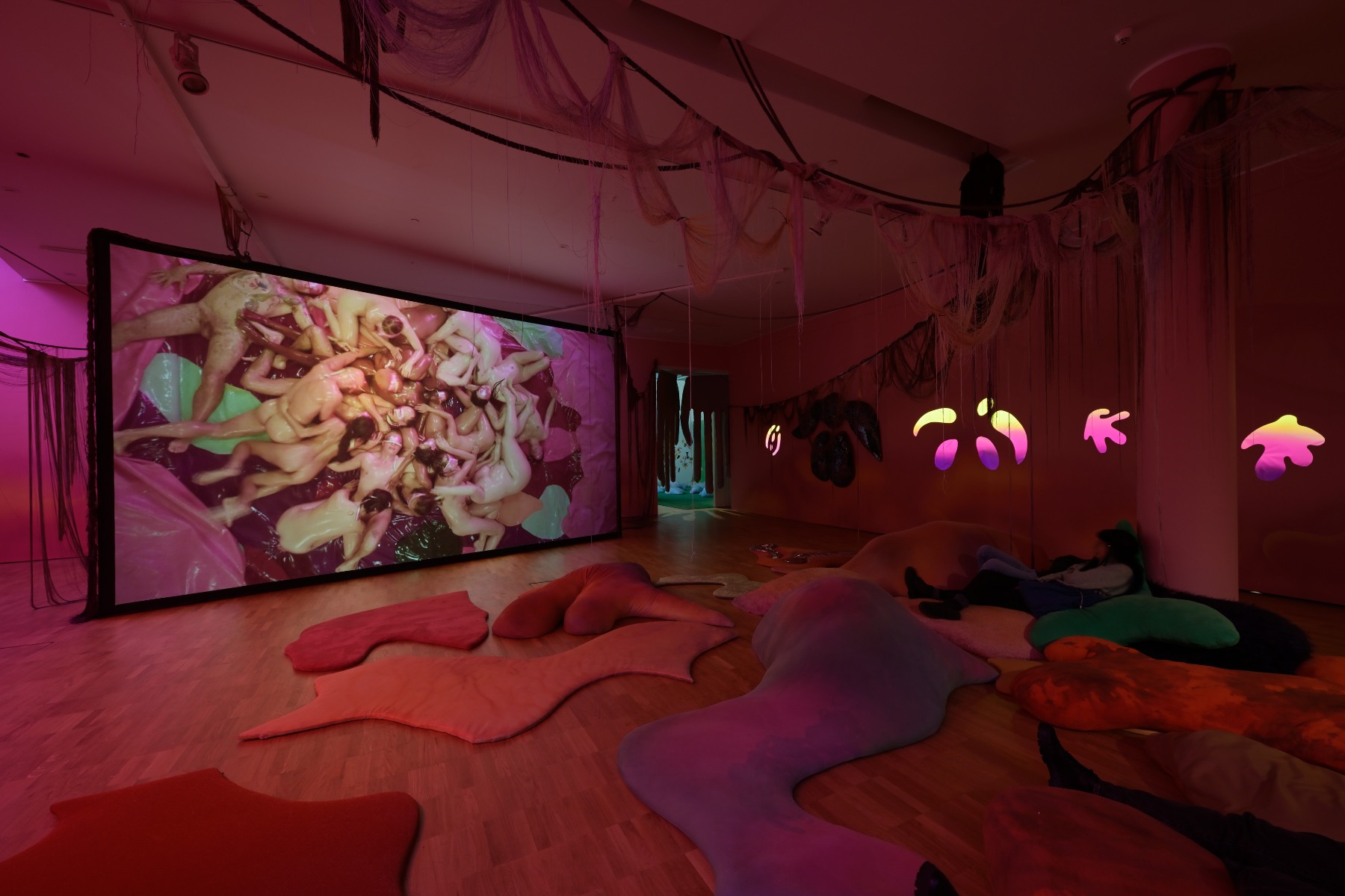
You have pointed out that today's so-called epidemic is loneliness. In addition to this overly digitalised world, why do you think we are so lonely? Why is loneliness such a common problem in our society today?
Personally, I felt a sense of loneliness because I was lacking closeness and relationships of surrender and trust. That’s something I also experienced in childhood as I gradually grew up and entered adult society. In our society, individualism and external rewards are very promoted and highlighted. Having power over others is really encouraged, and it is the sense of status that is important.
Once we externalise our needs, we also pay a price. It comes with the price of detachment, of feeling disconnected from resources, from the planet – in order to exploit it and other people, etc. It’s a matter of prioritising. Even if I don’t want it, I am pushed into a system that emphasises these traits – that everything around you is useful and can be used as a tool. It is very difficult to break out of this system because I am surrounded by people who uphold that system. Moreover, if you happen to not be involved in ‘conventional family building’ – e.g. you’re queer, etc. – you need different methods of reformatting this kind of closeness. This is just another layer on top of it.
Because of my own needs, I started organising ‘cuddle parties’. I just needed to feel intimacy and touch that wasn’t necessarily romantic or sexual. I wanted to feel relaxed in a shared space with others.
melanie bonajo. Progress vs Regress. 2016. Video still. Scenography and installation in collaboration with Théo Demans. Courtesy of the artist and AKINCI
melanie bonajo. Progress vs Regress. 2016. Video still. Scenography and installation in collaboration with Théo Demans. Courtesy of the artist and AKINCI
In addition to ‘When the body says Yes’ (2022), you have three other projects exhibited at Kumu. I would like to ask about the work ‘Progress vs Regress’ (2016), which explores the influence of technological innovations on social relationships through the perspective of today’s elderly population – the age cohort that has experienced the most sudden industrial, technological, and digital changes in the history of humankind. I think this is where the aspect of social inclusion emerges regarding how can this generation feel that they are socially included and part of something bigger, and that there is someone who relates to them. What was your takeaway from this project, and do you think that artists deal with these kinds of topics frequently enough?
I was very interested in finding out if our notion of having undergone progress was actually true – that we really are living better, have more of everything, etc. Is it true that our quality of life has improved, or does it come with a cost – with a price that we pay in terms of social relationships? Does it affect how we either feel or don’t feel connected to ourselves, to each other, and to the world around us? I interviewed a group of elderly people who were all around one hundred years old. They have gone through vast technological development in their lives. When they went to primary school, there were discussions of introducing the telephone to wider society – it was a huge social debate. There were advocates of the telephone, and then there were people against it who believed that people were not communicating with each other anymore, and that the telephone would only spoil social relations even more. And look where we are now…
Because of the exclusionary nature of technology, these elderly people usually do not know how to use telephones or other devices. They are not part of the consumer market or the labour market. In capitalism, they cannot be capitalised upon – they do not ‘contribute’ – they ‘cost money’. So, the only way we can capitalise on the oldest generation is by selling them medication, and that’s just heartbreaking.
Exhibition view. ‘When the body says Yes+’ at the Kumu Art Museum. Photo: Stanislav Stepaško
A lot of them – at least in the Netherlands – move into elderly care apartments, resulting in a lot of older people with different social backgrounds being put together into one common space. And there is no one who could introduce them to these devices. A lot of them feel very depressed – they are on antidepressants and sleeping medications. And no one visits them because we all are too busy with ourselves.
They also spoke about societal changes that they observed as they got older, namely, the increase in violence in today’s society. When they were children, they maybe had heard about one murder that had taken place in their neighbourhood, but now the amount of violence has gone over the roof. I am interested in what these kinds of social factors do to trust – how they affect our trust in each other and so on.

In contrast to this, in the work ‘TouchMETell’ (2019) you worked directly with children. What was your experience working with children for an art project?
I love to work with all different types of social groups, and to make sure that different groups are represented. I love working with kids – it is amazing. It’s important for me to value their voices and opinions because in our Western world, kids’ opinions are often not valued or taken seriously because ‘they are still kids’, and maybe naïve, or ‘they base everything too much on their feelings’. Yet kids often experience great empathy and a feeling of connectedness with the world around us. They have vision and a sense of truth that is very valuable to listen to. Once children get older, they are programmed by our culture and by the agreements made by society. We prioritise feeling in control of our emotions – if you’re too emotional, you’re naïve. Hence, for me, the perspective of children is a great source of information and potential wisdom.
During the project I asked kids how they feel about their bodies and what they feel comfortable about and what they do not. Kids can answer these questions very well. I tried to teach them simple rules about the body, and that if they need comfort, it’s okay to ask for a hug, etc. For kids, it is so easy to learn and acknowledge the space that they need, and what is normal and what is not. They also know how to take a moment or some space for themselves. With this work, I tried to give the viewer ‘another option’ for social interaction.
Exhibition view. ‘When the body says Yes+’ at the Kumu Art Museum. Photo: Stanislav Stepaško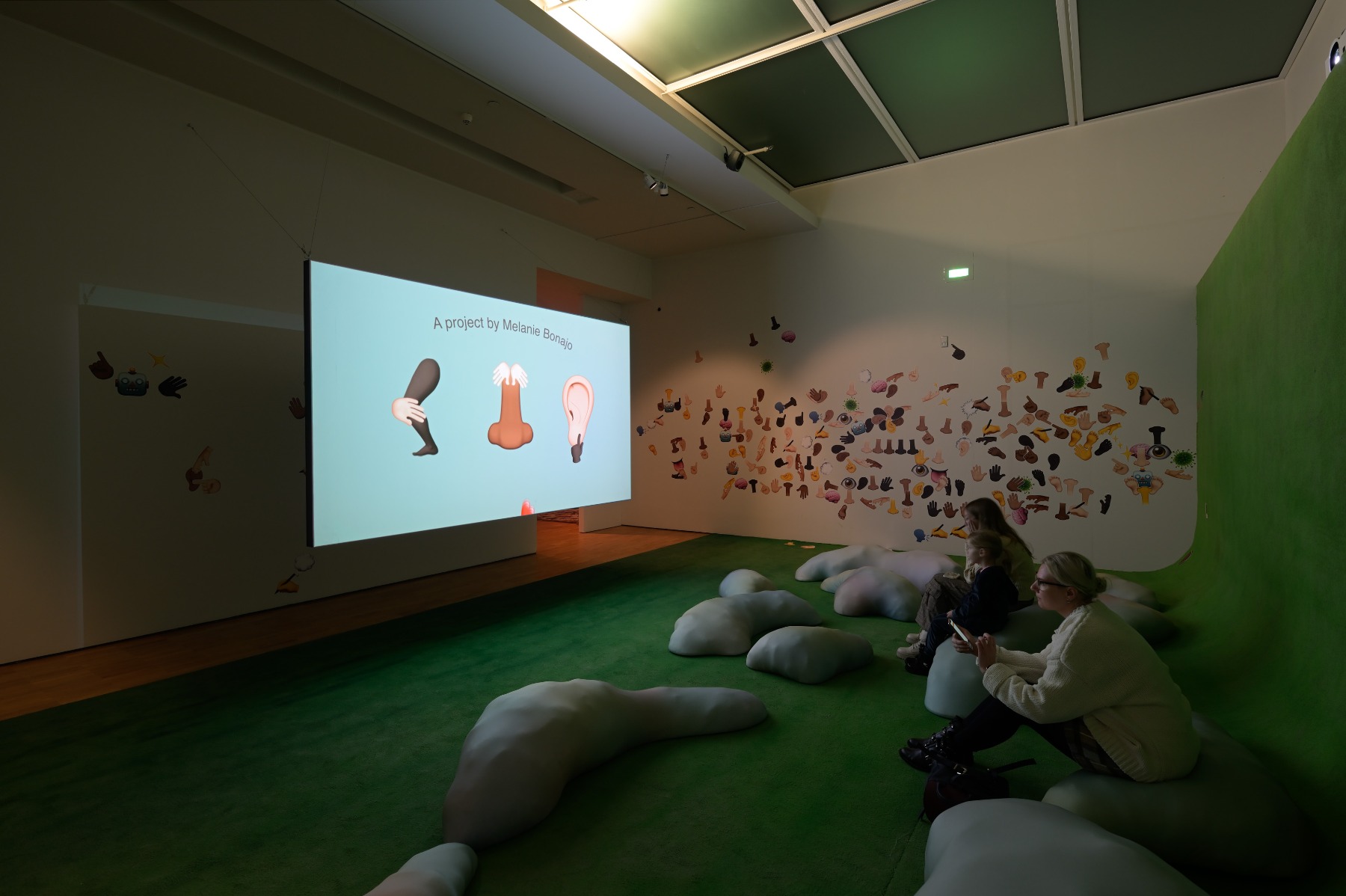
Exhibition view. ‘When the body says Yes+’ at the Kumu Art Museum. Photo: Stanislav Stepaško
One way that you stand out in the contemporary art field is with your audience-inclusive body-work sessions and various cuddle-and-touch workshops. What is the role of this practice in your overall work?
When I was growing up, I did not know how to touch people. I felt an interest, but I just felt lost. Nobody taught me about closeness. I did not know what I like about my body, and who is allowed to touch me, in what way, etc. You’re just thrown into life, and you’re supposed to figure it out. So, my journey started with the fact that I wanted to learn more about touching other bodies. I want to feel how other bodies feel – just out of curiosity. And from very early on, I started to do massage training and explore what it feels like. I felt very interested in this nonverbal space, just sensing and feeling other bodies. It’s such a rich source of information, and how somebody ‘feels’ in a physical sense is so different from how you would describe them in your mind. That’s why I also advocate doing a lot of things in the workshops blindfolded. You get a whole different blueprint of who someone is – it is so interesting. It’s a trip, I tell you.
From practicing this, I’ve also realised all the unprocessed traumas that I had been keeping and how much this was influencing my life. I wanted to reclaim agency and choice, and feel empowered in these situations...to really reclaim saying ‘no’ but also being able to say: ‘Yes I like this, I want this’, and invite other people in practicing the same. While doing these workshops, I realised how powerful this work is especially for women. I also learned how much all genders can learn about their own body, about consent, and about their desires and being able to communicate them.
Exhibition view. ‘When the body says Yes+’ at the Kumu Art Museum. Photo: Stanislav Stepaško
In your works, one notices notions of how we perceive the body as well as what is socially considered normal about the body and what is not. Can one say that your goal is to rethink – or eliminate – these taboos commonly associated with the human body?
Yes; it is a big theme in our society. Everything is about representation – how do you look to others, certain body types (especially, of course, if you’re female), and so on. And it’s a separate topic in itself if you’re on the gender spectrum, beyond the binary, etc.…
I really believe that our body is a miracle. It really is a gift; it’s a fantastic experience to have a body. To have a body in terms of movement, but also in terms of how we connect, is incredible. And to destroy that notion – to make it about something so superficial and to take away all this potential joy and beauty that we can experience – is a crime. I especially want women to feel comfortable in their bodies, to enjoy and celebrate it – not everything is about how you come across to others.
In our culture, the range of what is considered beautiful is narrow, whereas in other cultures, the range is often wider and everyone is celebrated. For me, celebrating the body is really something I want to push to the forefront. It’s a short ride – please, prioritise the beauty you already have!
Exhibition view. ‘When the body says Yes+’ at the Kumu Art Museum. Photo: Stanislav Stepaško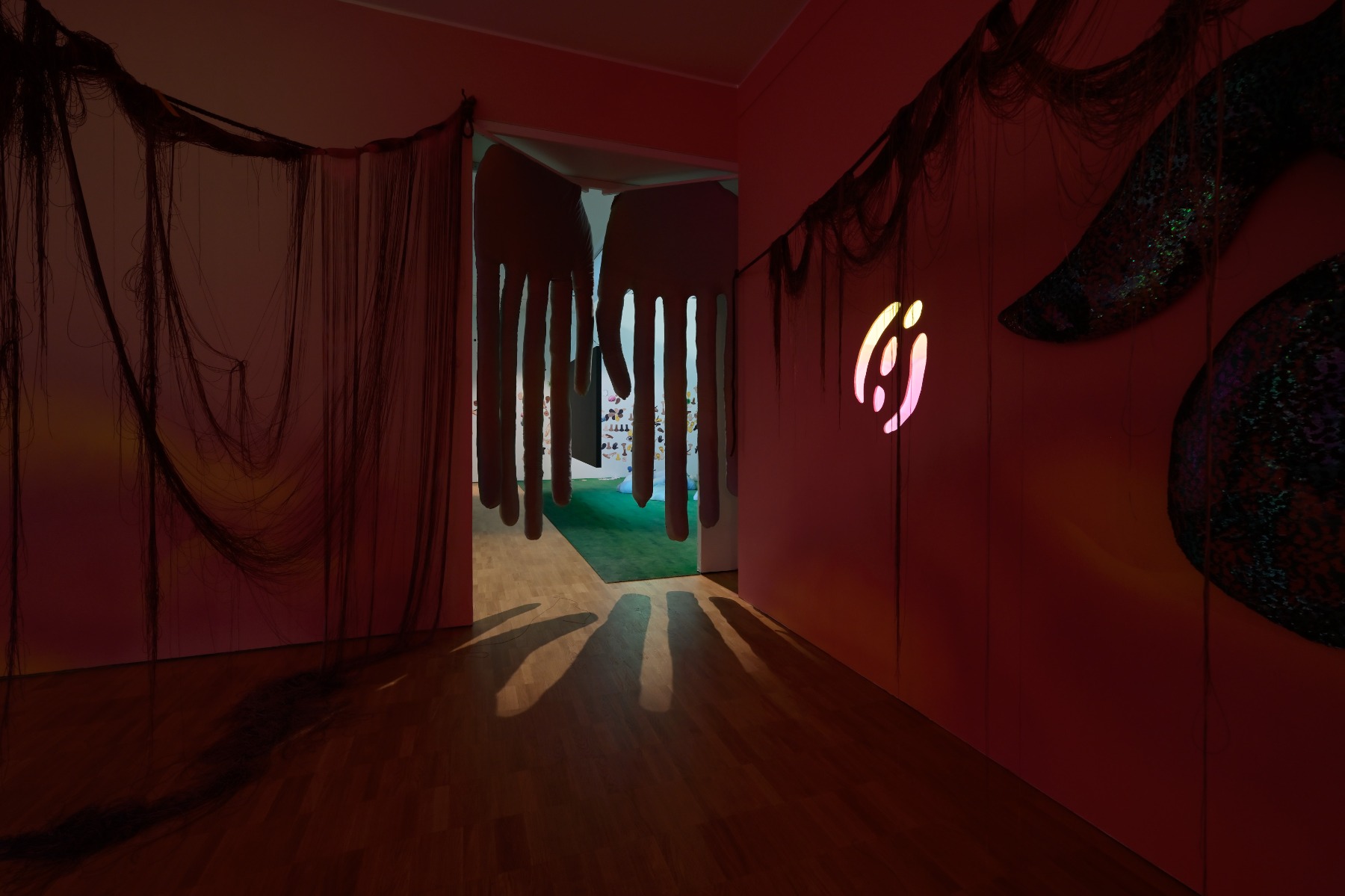
On one side we have conventional beauty ideals and stereotypes that have been held for decades, while on the other side we have the topics of body politics and freedom. To what extent is our body – in our modern Western society – politically and socially controlled in everyday life? What we can do so as to, in a sense, ‘release the body’?
I think it is very controlled. Unfortunately, seeing a group of people happy and naked in a pool of oil seems threatening to a lot of people. Ask yourself why? They are just having fun. We see people who are not ‘supposed’ to be comfortable in their bodies. And when I am working as an artist, I see that my work is censored SO much. My work, in my opinion, is not about sexuality, per se; it is also not about excluding sexuality. For me, it is about freedom and showing your body in a space of expansion and fun. Nakedness is part of it – it’s good, it’s a sense of freedom. You take off your clothes and you are someone else. Within our Christian capitalist and patriarchal society, nakedness is often seen as a threat because it’s not beautiful in the conventional sense or according to ‘the male gaze’. I think it’s about owning your own gaze, and that’s a threat to the status quo. I feel I am owning my body. I am owning what I do with my body and how I represent my body, and that’s an act of activism.
Exhibition view. ‘When the body says Yes+’ at the Kumu Art Museum. Photo: Stanislav Stepaško
I wanted to ask you about the concept of collectivity, which seems to frequently come up in your work. In a way, your work is creating a collective, or common, space for people. How, and through what kind of actions, can we create these kinds of shared spaces?
To collectively ‘be’ is hard work. I think we kind of lost it by pushing forward the concept of a ‘nuclear family’, by the way our labour system is constructed, and by how our social systems of care work. For example, how we take care of strangers has kind of...eroded.
I often remember travelling to various places and the people there saying, ‘Oh, you’re not from here? Come to my house and I’ll give you some soup’. In many places where I’ve been, this sort of hospitality is a normal part of their society. This would never happen in my hometown. That’s why I am interested in learning and re-discovering how group dynamics work (also in different cultures) – how two people can feel both empowered and comfortable, how people can collaborate, and how people can share common visions and efforts. This is the future I wish to reclaim.
I also feel that trust building is important. In my work, I focus a lot on trust and what it really means. I remember all the times when I was told not to trust someone and not to share my resources: by the school system, by family, by social circles, etc. And this has impacted me. I do not want to be like this, and I feel that people were not like this in the past. It’s important to rebuild these structures and find common ground.
Artist melanie bonajo. Still from a video made by Rasmus Kosseson. Kumu Art Museum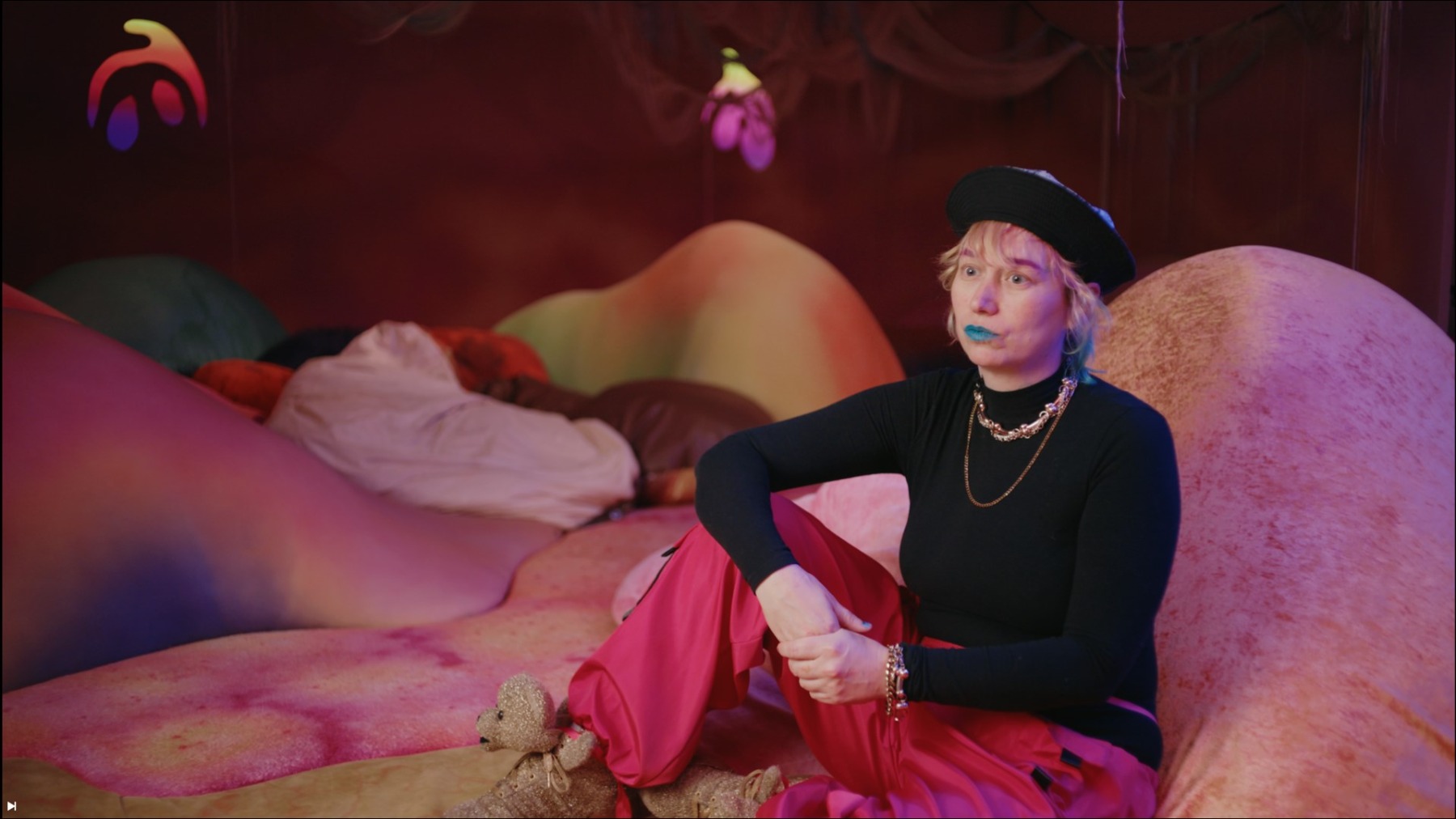
Your work also offers a so-called refuge for marginalised communities who work and live on the fringes of society, either through cultural exclusion or because of not belonging to the normative system. You also make very international projects. How do you reach all these different communities? How do you ensure that the content of your work reaches them? And how do you find ‘the right people’ to collaborate with?
For example, I did a series of short documentaries – “Night Soil Trilogy” – which engages with women users of ayahuasca, sex-work activists, and an array of alternative farmers. The trilogy considers the socially and ethically progressive facets of these practices – some of which have been deemed illegal. There were many different participants, of which one example are sex work advocates. When I was starting my journey and these studies, I was doing a lot of work around this subject, and I was not part of that community, but now I am. And there are many other examples like that.
I also feel that the times are changing – first, such communities were on the margins of society, but now these topics are really in the mainstream conversation; it is way more present. There was a shift in the Zeitgeist.
melanie bonajo. When the body says Yes. 2022. Video still. Scenography and installation in collaboration with Théo Demans, commissioned by the Mondriaan Fund. Courtesy of the artist and AKINCI
When do you think this shift happened?
This shift happened, I think, when the #metoo movement emerged...with social media, the Black Lives Matter movement – all these hardcore social media waves where everybody was thrilled and educated but also in a position of privilege. So many voices came out, so much anger, and so many nuances. People started reformulating groups and alliances, and the gender revolution happened: people started coming out as trans, non-binary, etc. The complexities around sexual orientation emerged.
I think a lot of things fell into a new place during this period. It gave a lot of new opportunities to people who did not have an outlet, who felt socially awkward, etc. I think there were a lot of good things; I felt a moment of education. And there was also, again, a moment of repair. Like, how are we going to come together again? Sometimes we are on the oppressed side, and sometimes we are on the side of the oppressor. How do we come back to a space of shared humanity? I feel that “When the body says Yes” is an answer to that.
How much do you think an artist can change these kinds of societal perceptions, beliefs and behaviours?
I am very happy when one person feels change. I feel happy when somebody finds something that is valuable to them and that they they can integrate it into their lives and give space for that. Because that is really where I started.
How you did come to art in the first place?
Well, I think I was always a very creative child. Making and doing stuff: drawing, building, etc., but also organising community events. I was the social organiser of the neighbourhood – things like figuring out how to get parkour areas built [laughs]. I was very hungry for new worlds and new knowledge. There was great motivation to learn and to speak to other people. I was also interested in why people do and choose certain things, and why do I feel weird and excluded in my culture? Why do I often feel that I do not belong? Why do I feel there is so much that is wrong in my body?
I started with myself and my parents. My first work was about reflecting on my childhood, looking into why we did different things, and putting my parents in different roles. From there it just gradually grew into ever larger societal reflections and projects. I was also interested in social and cultural agreements in my surrounding environment as well as in other cultures: What do they do, and why do they do this? I often asked how much people’s actions and habits are influenced by their surroundings, religions, and so on – meaning, how does the culture melt and transform human beings?
melanie bonajo. Matrix Botanica – Biosphere Above Nations. 2013. Video still. Courtesy of the artist and AKINCI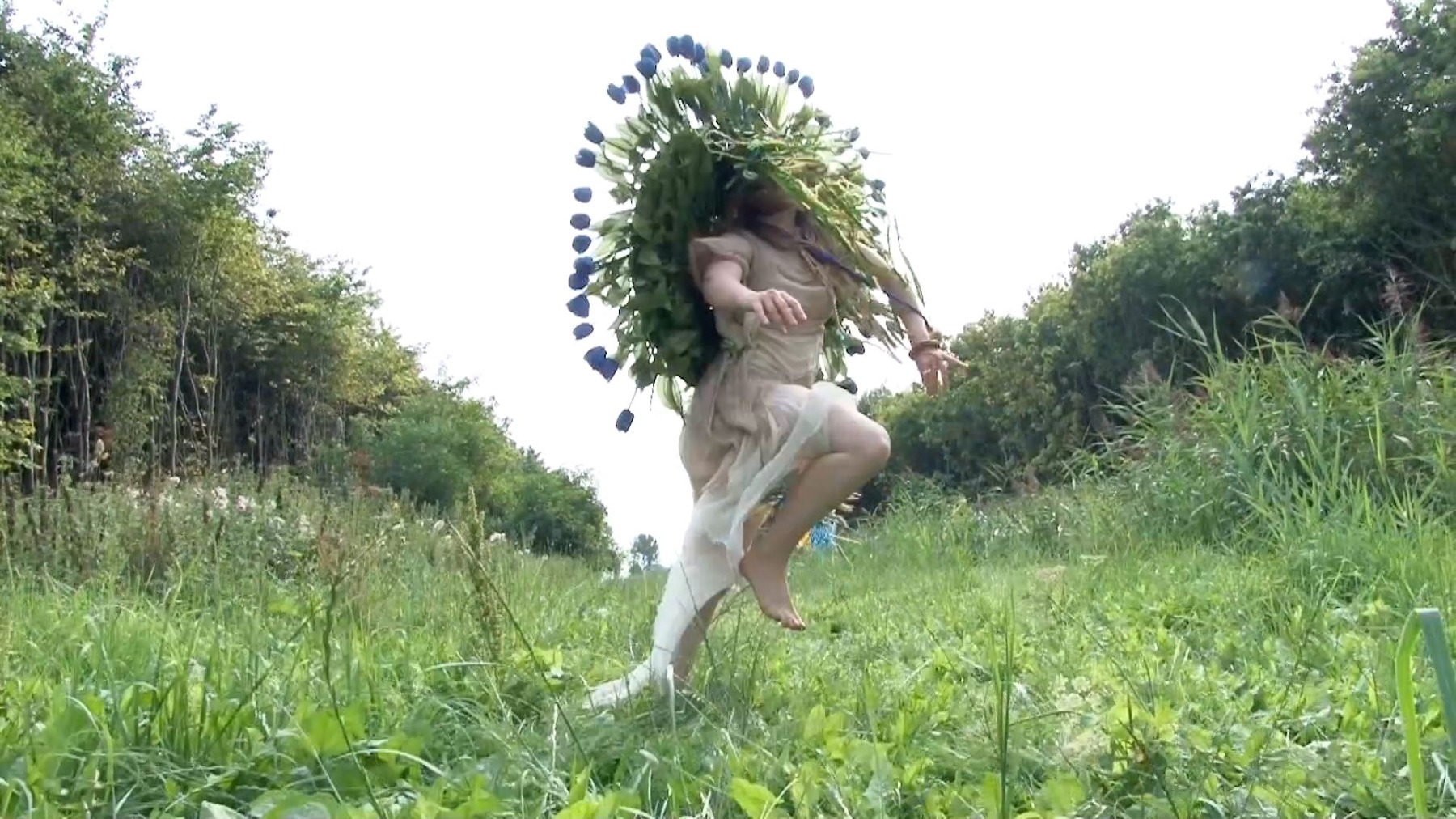
What is the relationship between the message and the visual language of your work? Is one side more important than the other?
First, I love images. And I think they go together. When I got my first camera, I was ten years old – it was a small one. I really wanted to have a camera, and that was a big joy for me.
I think the image is also a form of activism. It has the potential to present a radical and different imagined model of how we can be together as humans. And I think it is totally interwoven with the message. Of course, there are various techniques of empowering an image: with sound, light, or the length of the clip... It is a certain style that an artist develops.
You once said that you are really interested in ‘playful ways of filmmaking’ and ‘reinventing the moving image’. Can you explain how you specifically reinvent the moving image?
For me, the act of filming is like a ceremonial space, like a ritual. It has a very high intensity of presence, and this changes things in the matrix of reality. It changes things in my body and in the bodies of the people who are somehow involved. It’s a space of transformation, and often a space of unknowing. This unknowingness is part of the method, but it is very difficult to describe this process to others. For me, it is magic; it is a mystical process. I feel it is very intuitive. There is logic to it, but it is not rational. And I know how this logic works, but I cannot explain it.
melanie bonajo. Matrix Botanica – Biosphere Above Nations. 2013. Video still. Courtesy of the artist and AKINCI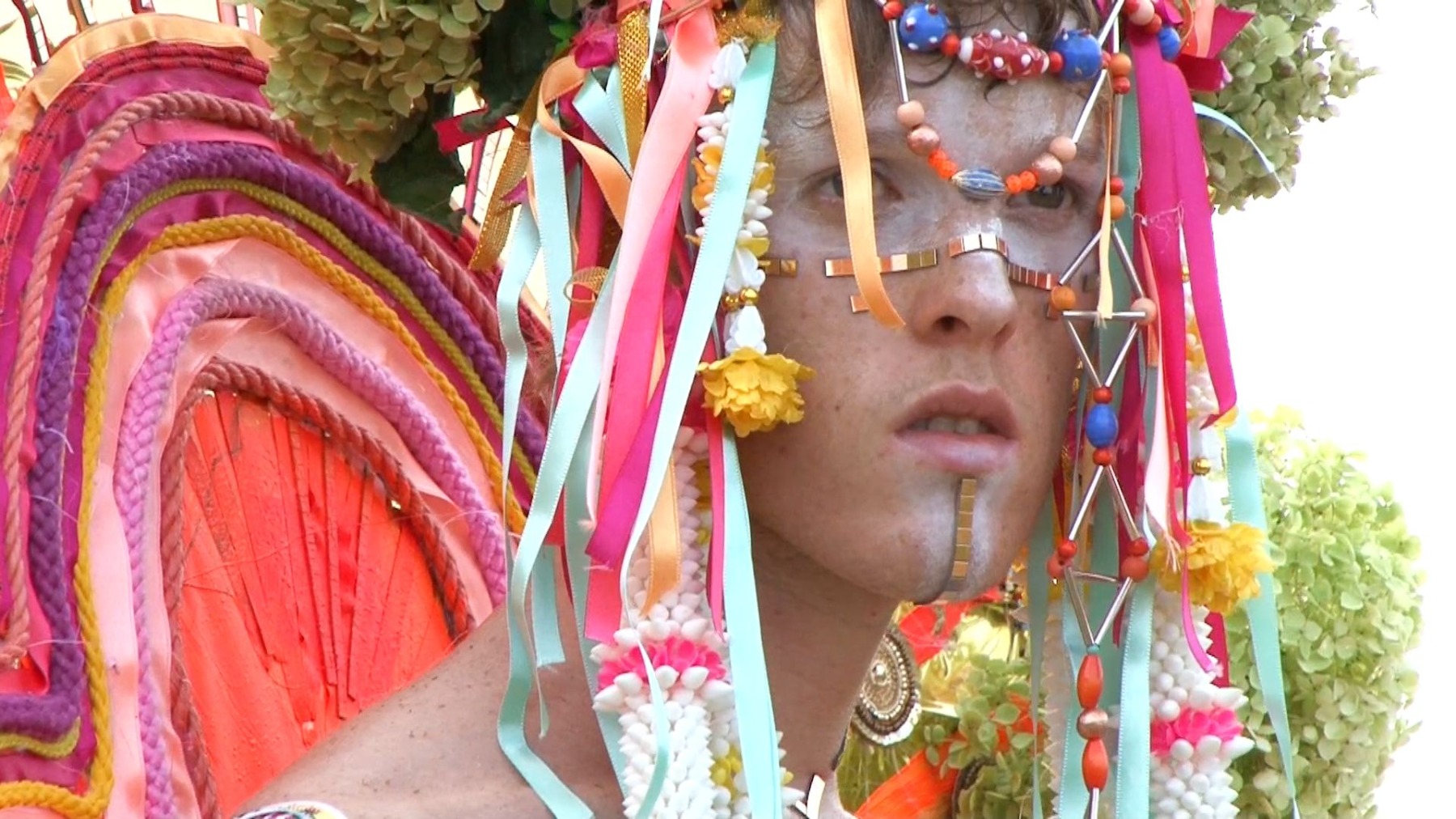
I’ll reformulate the question this way: Why did you choose video as your main medium?
I came to video from a world of cameras and photography, and I feel there are a couple of reasons for my choice. One, it is easily distributable – when you have a file, you just send it and you can show it anywhere in the world. It’s simply an easy way to spread the message.
But there were some complexities of video and filmmaking that, for a very long time, I was not ready for. That was because the video medium is, in a way, so raw and so very much ‘in the moment’ – it was easier for me to stay with photography. Video was faster and not as collaborative. But at a certain point, I felt I was ready to do film. And I am still doing it, and I am starting to love it more and more because I am getting better at it [laughs].
I think filmmaking is a place where so many art forms come together. It is a space of sound and image, a space of performance, and also a space for storytelling and narrative. It brings together all these elements that used to be separate. And it also creates a new space – together with installations and scenography – with which people can become involved; this is something I really value.
I wanted to ask about the installation solutions that you’ve done in collaboration with Théo Demans and that are often exhibited next to your videos – they’re a bit like extensions to the space. What is the role of these installations?
These installation spaces are created to invite the visitor in – to invite people to move their bodies in different ways within a social space and to change the proximities of their bodies to one another. I’m interested in how our nervous systems work when our bodies are in various positions and when they interact with others. Your body memory may remind you of many other spaces that you’ve been in before, but if you lie down, it’s a bit like a blank page and you have the opportunity to experience something in a new and unknown way.
Are you working on any new topics?
I’m currently working on a collaborative project called ‘The School of Lovers’, which translates for people who have cognitive disabilities the subjects that fall under somatic sex education; it also explores how we can include these people more. They are often isolated and rarely experience the touch of another person; they do not have access to romantic or close relationships. Often times, other people decide what happens to their bodies and so on. I would like to bring more agency to this topic.
Another film that is going into production is the third one in the ‘Progress’ series. Called ‘Progress vs Mother’, it is all about the symbol of ‘the mother’ – The Other. It investigates the judgements around reproduction, kinship, and care, and looks into all of the taboos related to motherhood. This is a real Pandora’s box. I have been working with this theme for seven years now. Every time I talk about it to someone, they have a story to tell me – which indicates that we need a new narrative around this topic.
MEL aka Purrrrr. Healing Gif portrait by Joseph Marzolla
What are some thoughts and feelings that the viewer can take away from the Kumu exhibition?
I hope it makes people reflect on their own relationships to touch, intimacy, sexuality, consent, etc. I hope it makes the visitors realise where they want to take themselves in this journey. To explore how they feel about their own bodies, and if they feel shame or judgement when looking at a bunch of naked people rolling about in oil. They might also reflect on how we teach children when it comes to these subjects.
It’s also important to notice how you feel in your body while viewing the exhibition; try to understand the impact these feelings have. You can learn a lot about yourself through these feelings.
